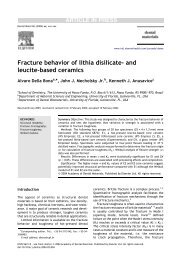Micro-tensile bond strength of adhesives bonded to class-I cavity ...
Micro-tensile bond strength of adhesives bonded to class-I cavity ...
Micro-tensile bond strength of adhesives bonded to class-I cavity ...
You also want an ePaper? Increase the reach of your titles
YUMPU automatically turns print PDFs into web optimized ePapers that Google loves.
<strong>Micro</strong>-<strong>tensile</strong> <strong>bond</strong> <strong>strength</strong> <strong>of</strong> <strong>adhesives</strong> <strong>bond</strong>ed <strong>to</strong> <strong>class</strong>-I <strong>cavity</strong>-bot<strong>to</strong>m dentin after thermo-cycling 1003<br />
Figure 2 mTBS after thermo-cycling. The box represents the spreading <strong>of</strong> the data between the first and third quartile.<br />
The central vertical line represents the median. The whiskers denote the range <strong>of</strong> variance and outliers are represented<br />
by a dot.<br />
Discussion<br />
The hypothesis that thermo-cycling <strong>of</strong> res<strong>to</strong>red<br />
occlusal <strong>class</strong>-I cavities (repetitive contraction/<br />
expansion stress) as well as <strong>of</strong> mTBS sticks (diffusion-dependent<br />
hydrolysis and elution) does not<br />
decrease mTBS was confirmed, as for none <strong>of</strong> the<br />
<strong>adhesives</strong> a decreased mTBS was recorded after<br />
thermo-cycling (20,000 cycles). Because <strong>of</strong> the<br />
specific study design, in which thermo-cycled as<br />
well as non-thermo-cycled sticks originated from<br />
the same teeth (Fig. 1), an additional paired<br />
analysis was carried out <strong>to</strong> compare the control<br />
and thermo-cycling/stick group. This analysis is<br />
more powerful than the standard ANOVA analysis,<br />
because the variable ‘<strong>to</strong>oth’ was statistically<br />
excluded. Also using this more powerful analysis,<br />
no significant effect <strong>of</strong> thermo-cycling was<br />
recorded for OptiBond FL (pZ0.68), nor for Clearfil<br />
Protect Bond (pZ0.8624).<br />
S<strong>to</strong>rage <strong>of</strong> small mTBS specimens in water for<br />
relatively short periods (3 months and longer) can<br />
significantly reduce the mTBS [13]. Given the long<br />
time needed <strong>to</strong> implement the thermo-cycling<br />
Table 3 Failure analysis under the light microscope.<br />
Experimental group Interfacial Mixed failure<br />
failure<br />
a<br />
Failure in Total (n)<br />
resin<br />
OptiBond FL Control 1 5 5 11<br />
Thermo-cycling Cavity 2 5 4 11<br />
Stick 4 7 2 13<br />
Protect<br />
Bond<br />
Control 0 6 5 11<br />
Thermo-cycling Stick 1 5 8 14<br />
Cavity 0 8 4 12<br />
1 3<br />
Thermo-cycling Stick 0 3 b<br />
1 4<br />
Cavity 1 b<br />
5 b<br />
3 9<br />
iBOND Control 0 2 b<br />
a Mixed failure, interfacial failure and failure within resin.<br />
b Feg-SEM evaluation revealed that some interfacially failed areas, actually failed within resin (Fig. 5).
















